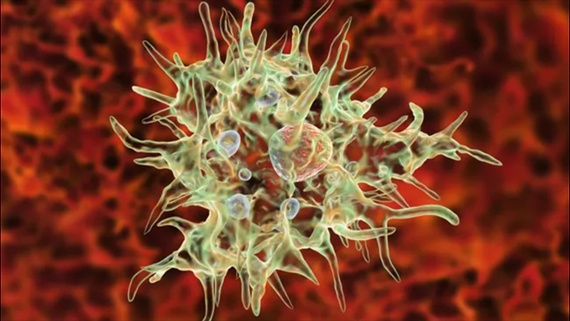#Collins Dictionary The word of the week is... This week, we're celebrating National Pi Day by rounding up our mathematical words of the week. Celebrated around the world on March 14th, National Pi Day is the perfect opportunity for maths enthusiasts to recite the infinite digits of pi, discuss all things math and even celebrate with a slice of pie. Pi is one of the most well known mathematical constants. It is the ratio of a circle's circumference to its diameter and is usually approximated to 3.142, however, its digits are infinite and never repeat. So, whether you skipped maths class regularly or remain a keen mathematician to this day, we hope our words of the week will remind you of the wonder of pi. #Quanta Magazine |
| | Swirling Forces, Crushing Pressures Measured in the ProtonBy CHARLIE WOOD Long-anticipated experiments that use light to mimic gravity are revealing the distribution of energies, forces and pressures inside a subatomic particle for the first time.
Read the article |
|
 | Tiny Tweaks to Neurons Can Rewire Animal MotionBy ELISE CUTTS Altering a protein in the neurons that coordinate a rattlesnake’s movement made a slow slither neuron more like a speedy rattle neuron, showing one way evolution can generate new ways of moving.
Read the article
Related:
Brain Chemical Helps Signal
to Neurons When to Start a Movement
By Allison Whitten (2022) |
 | What Is Quantum Teleportation?Podcast hosted by JANNA LEVIN Teleporting people through space is still science fiction. But quantum teleportation is dramatically different and entirely real. In this episode, Janna Levin interviews the theoretical physicist John Preskill about teleporting bits and the promise of quantum technology.
Listen to the podcast
Read the transcript
|
|
 | Physicists Finally Find a Problem Only Quantum Computers Can DoBy LAKSHMI CHANDRASEKARAN Researchers have shown that a problem about the energy of a quantum system is easy for quantum computers but hard for classical ones.
Read the blog
Related:
The Quest to Quantify Quantumness
By Charlie Wood (2023) |
 | A Mathematician On Creativity, Art, Logic and LanguageBy JORDANA CEPELEWICZ Claire Voisin, the recipient of the 2024 Crafoord Prize in Mathematics, discusses math as art, math as language, and math as abstract thought.
Read the interview
Related:
A Mathematician Dancing Between Disciplines
By Rachel Crowell (2022) |
|
|
| Each week Quanta Magazine brings you an update on one of the most important ideas driving modern research. This week, biology writer Yasemin Saplakoglu describes where our microbiome comes from and the myriad ways it governs our health. |
|
How the Microbiome Influences Our HealthBy YASEMIN SAPLAKOGLU |
|
We are never alone. In addition to 30 trillion human cells, our bodies are home to some 39 trillion microbes — bacteria, fungi and protozoa that live in our gut, lungs, mouth, nose, skin and elsewhere throughout the body. The assemblies of organisms found in and on our body, the “microbiota,” are parts of broader microbial habitats, or “microbiomes,” that encompass all the viral and cellular genomes, encoded proteins and other molecules in their local environment. (However, there is some ambiguity in the definitions, so the usage of the terms often varies.)
Though the microbiome has recently become a hot topic because of its potential significance to our health, it’s not a new concept. Some trace its origins back to the 17th century, when the Dutch microbiologist Antonie van Leeuwenhoek first described tiny organisms that he sampled from his mouth and viewed under a handcrafted microscope. Throughout the 1900s and early 2000s, a number of discoveries drew people’s attention to the bugs living inside us, but the field got an infusion of attention in 2007 when the National Institutes of Health launched the Human Microbiome Project. Since then, scientists have extensively cataloged the human body’s microbial biodiversity in increasing detail. They’ve found that microbiomes are distinct throughout the body: The microbial makeup of the intestine, for example, is very different from that of the mouth. They have also come to recognize that there isn’t a “normal” microbiome. Rather, as with fingerprints, everyone harbors a unique selection of microbial species and strains.
These microbes play many roles, from protecting against pathogens and tuning our immune responses to digesting food and synthesizing nutrients. Because of this, when a microbiome is thrown into disarray — such as through bad diet, infectious disease, medications or environmental factors — it can have a ripple effect on our health. Unhealthy microbiomes have been linked to cancer, heart and lung diseases, inflammation, and inflammatory bowel disease. Microbes are even thought to regulate the gut-brain axis, a communication highway that connects the brain to the enteric nervous system, which controls the intestines. Now, medicine is increasingly targeting microbiomes to treat various ailments. For example, fecal transplants that contain healthy microbiota are sometimes used to treat severe bacterial infections in the colon.
Despite an acceleration of microbiome research over the past few decades, resulting in powerful new genomic technologies, many fundamental questions remain to be fully answered. How do we acquire microbiota and how does the community shift throughout our lifetimes? How do different environments and lifestyles impact the microbiome? How can the microbiome cause, or be used to treat, diseases? These and other questions are driving biological research and helping us better understand who and what makes us who we are.
What’s New and Noteworthy
Where does our microbiome come from? Several studies over the past year have yielded insights. Babies acquire most of their microbes from mom at birth and in the months that follow. But it turns out that mothers don’t only share microbial organisms with babies — they also share microbial genes. In a 2022 study published in Cell, scientists revealed that short sequences of DNA called mobile elements can hop from the mother’s bacteria to the baby’s bacteria, even months after birth. As I reported in Quanta, it’s likely that these genes could help seed a more capable gut microbiome in the baby, which in turn could further develop the baby’s immune system.
Transmission doesn’t only happen at birth. In fact, microbiomes are incredibly dynamic and can change drastically throughout a person’s lifetime. In a Quanta article published last year, I reported on the most comprehensive global analysis of microbiome transmission to date. Using new genomics tools, a team of Italian biologists traced more than 800,000 strains of microbes between families, roommates, neighbors and villages in 20 countries. They discovered that microbes hop extensively between people, especially between spouses and roommates, who spend a lot of time together. These findings suggested that some diseases that aren’t considered contagious might have a contagious aspect to them, if they involve the microbiome. However, that idea is speculative and will surely be debated and studied in the coming years.
Insights into how we acquire the microbiome and how it impacts our bodies don’t just come from studies of humans. Other animals also have microbiomes that are critical for their health and development — and several recent studies have drawn links between gut microbes and the brain. In 2019, Quanta reported that fear behavior differs between mice with different microbiomes, and in 2022 we reported on the ways microbiomes influence social skills and brain structure in zebra fish. |
|
| Science published a paper describing how a diverse microbiota helps protect against pathogens by consuming a wide variety of nutrients — leaving fewer nutrients available for potential pathogens. |
|
| MIT Technology Review unpacked a fraught ethical conflict around how scientists conduct microbiome research. In search of healthful microbes that may have been lost from industrialized and sanitized populations, some researchers are collecting feces from hunter-gatherer societies — raising concerns in those communities about consent, equity and impact. |
|
| Scientific American dove into research on the microbiome of the kākāpō, an endangered parrot from New Zealand, in hopes of garnering insights to save the birds from extinction. |
|
| Nature reported on the discovery of “weird” flat circles of RNA, smaller than viruses, which the researchers called “obelisks,” and which colonize human gut microbiota. |
|
| | |
|




































No comments:
Post a Comment